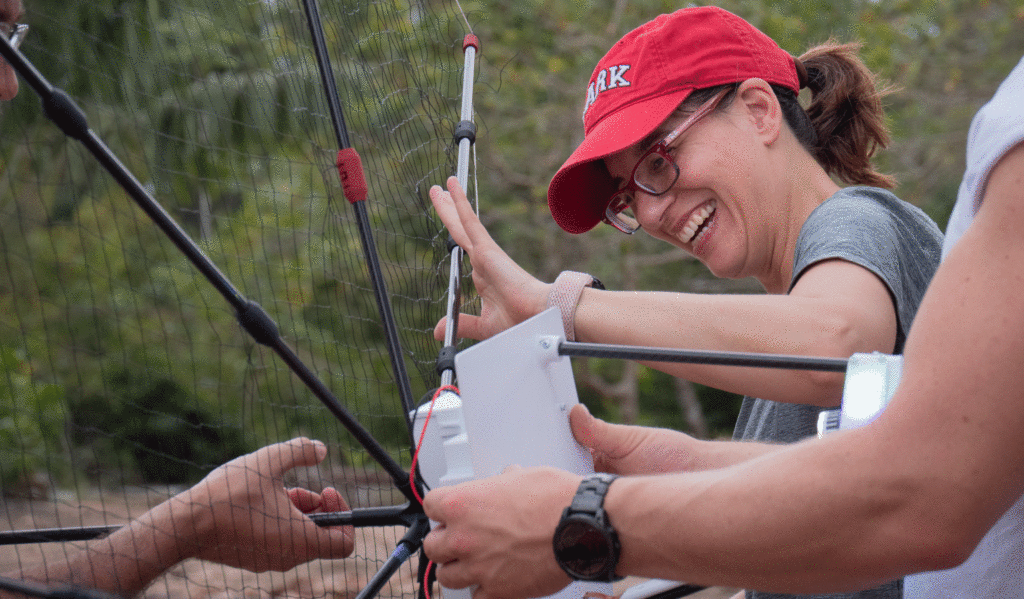Protecting Amazon’s Indigenous lands can improve human health, study finds
October 2, 2025
Florencia Sangermano, left, partners with members of an Indigenous community as part of the XPRIZE Rainforest competition in 2024. (Photos courtesy of Team ETH BiodivX)
Indigenous Territories in the Amazon rainforest can help buffer and protect humans from forest fire-related illnesses and, in many cases, animal- and insect-borne diseases, according to a recent study by Clark geographer Florencia Sangermano and her colleagues published in the Nature group journal Communications Earth & Environment.
The study was released just two months before COP30, the annual United Nations climate change conference, to be held Nov. 10-21 in Brazil, one of nine countries in the Amazon region. Clark hopes to send representatives from its newly launched School of Climate, Environment, and Society to COP in Bélem.
Drawing upon two decades of data on respiratory and infectious diseases in the region, “the study is the first to evaluate the human health benefits of Indigenous lands throughout the Amazon biome,” the authors say, “highlighting the complexity of these relationships in the face of different contexts of landscape structure, the legal status of Indigenous lands and the trade-offs that exist between different diseases.”
The Indigenous Territories have “complex relationships” with the landscape beyond their borders — the amount of forestland and forest fragmentation that exists in surrounding areas — which affects whether human disease spreads, according to the study.

Covering 4.35 million square miles, the Amazon region is home to 33 million people, 2.7 million of them Indigenous, and tens of millions of plant and wildlife species.
“A growing body of evidence shows that Indigenous-managed lands are largely forest covered, especially when legally held or titled,” the authors say. “Indigenous Territories … contribute to curb deforestation and slow biodiversity loss, underscoring the need to recognize and support Indigenous rights globally.”
The study highlights that such “policies supporting Indigenous land rights … are not only essential for protecting these populations,” the authors say, “but can also generate positive outcomes for human health.”
The article has drawn attention from around the world, including in The Guardian, India News, U.S. News & World Report, Inside Climate News, Mongabay, and other media outlets.
“Particulate matter emissions due to forest fires, and their related health impacts, transcend national borders,” Sangermano, associate professor in Clark’s Graduate School of Geography, told The Guardian. “International collaborative frameworks that align forest protection, Indigenous stewardship, and fire mitigation strategies across the Amazon biome are essential.”
“Our findings highlight the need for policies supporting Indigenous land rights, which are not only essential for protecting these populations but can also generate positive outcomes for human health.”
— study by florencia sangermano and co-authors
Over the past five decades, the Amazon has lost millions of acres of rainforest due to human activity, including forest fires used to clear the land for agriculture. The fires release noxious fumes containing fine particulate matter, which can lead to lung cancer, chronic bronchitis, asthma, stroke, and other serious respiratory and cardiovascular health problems, according to Sangermano, who was designated a Kavli Frontiers in Science Fellow by National Academy of Sciences.
In a 2023 study published in Communications Earth & Environment, Sangermano and her colleagues examined similar links between deforestation and threats to human health. Based on 10 years of satellite data compiled and analyzed by Sangermano, the scientists analyzed the effect of PM2.5 particulates — the fine particles — from forest fires on heart and respiratory diseases and the economic impact of these effects. They found that particulate matter can disperse, affecting people who live up to 310 miles away.
Meanwhile, the 2025 study points out that “land-use change stands as the leading driver for emerging zoonotic infectious diseases. Deforestation alters the niche of vectors, hosts, and pathogens, changing their community composition, behaviors, movements, and spatial distribution, and forcing them to live in closer proximity to humans,” the authors say. “Deforestation also leads to fragmentation, altering the configuration of the remaining forest areas.”
Sangermano has experience partnering with Indigenous and local people on environmental research in the Amazon. In Brazil, as part of the five-year XPRIZE Rainforest competition, she was a member of the global research team ETH BiodivX that eventually won a $250,000 Bonus Prize in 2024. Her expertise in ecoacoustics, geospatial science, and remote sensing helped inform the environmental insights the team derived from data gathered in the Amazon.
The team, she says, was “very happy to be recognized for the part of the work that we were the most proud of — working with the local communities and Indigenous communities.”
In addition to her research in the Amazon, Sangermano is studying the connections between rainforest loss in Brazil’s Atlantic Forest and rodents’ transmission of infectious diseases to humans.
“Healthy biodiversity systems,” she says, “have healthy animals and, in turn, healthy humans.”
Search
RECENT PRESS RELEASES
Related Post




